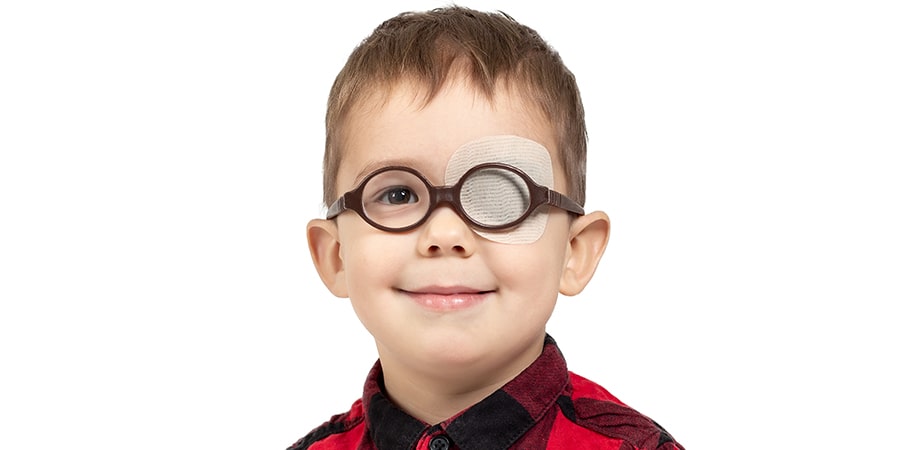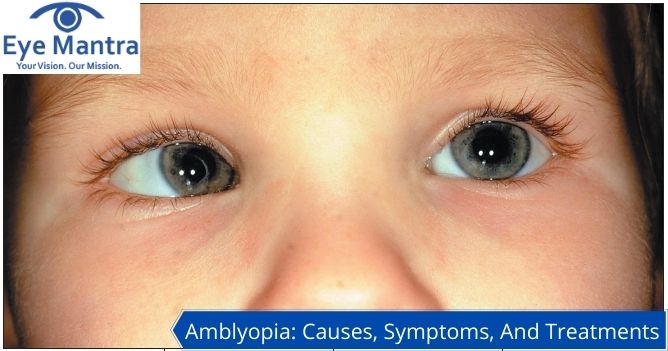Contents
What Is Amblyopia?
Amblyopia also known as lazy eyes occurs in children, whose eyesight does not develop with age as it should in one eye. In such cases, your brain only focuses on one eye and ignores the other, which becomes the lazy eye. Therefore, that eye is not stimulated properly leading to vision problems because of weak nerve cells. If this is not treated properly in time, then it might lead to permanent vision problems as the brain will stop focusing on that eye.
Amblyopia generally occurs in children between the age group of 6-9 years. According to the doctors if amblyopia is identified and treated before age 7, then the chances of full vision correction are the highest.
Symptoms of Amblyopia
A child having amblyopia is not able to see things clearly from one eye. The affected eye will not receive clear images so the brain will not get clear signals and as a result, the brain will eventually start to ignore it.
In some cases, the eye which is not affected covers the issue of the affected eye. As a result, the child is not able to notice any vision problem. Therefore, in such cases, amblyopia is generally not noticed until and unless the child goes for routine check-ups.
Common symptoms of amblyopia include:
- Blurred vision
- Doubled vision
- Poor depth perception
- Squint or shutting one eye
It is important to have an eye check-up at least once a year. Make sure you get your child’s eye check-up done especially if you have any family history of eye problems. Mostly in some countries, the first eye check-up is done at the age of 3-5 years.
Causes of Amblyopia
Anything that obstructs the vision in the developmental age can lead to amblyopia. Although the main reason is yet not identified but according to the doctors the brain suppresses the image coming from the affected eye.
Some of the possible causes leading to lazy eyes are mentioned below:
Strabismus
It occurs when there is an imbalance in the muscles around the eyes which might lead to turning or crossing out the eye. This muscle imbalance creates difficulty for both the eyes to track an object together. It can be inherited or can be the result of near or farsightedness. It can also occur due to some eye injury in childhood.
Anisometropic Amblyopia
It is a refractive error. In this, the light does not fall correctly on the eyes when it enters through the lens. Generally, it occurs due to far or nearsightedness, astigmatism, in this the surface of the cornea becomes uneven which further leads to blurred visions.
A child affected by this will have a problem of either farsightedness or nearsightedness in one eye than the other, which will further result in amblyopia in one eye.
Stimulus Deprivation Amblyopia
This is the rarest form of amblyopia. In this one eye is prevented from seeing therefore, it becomes weaker. In some cases, both eyes are affected.
The major reasons which may lead to such cases are:
- Scar in the eye.
- Cataract, in this the baby is born with a clouded lens.
- Ptosis also is known as droopy eyelids.
- Glaucoma occurs due to extreme eye pressure
- Eye injury during the developmental period.
Diagnosis of Amblyopia
All children should have an eye check-up before they are eligible to go to school. The doctor will make sure of the following things:
- Light entering the eyes is not being blocked due to any reason.
- Both the eyes are functioning well.
- The movement of both eyes is perfect.
If there is any problem with the mentioned things, then the doctor will suggest you get your child’s eyes checked by an eye specialist.
Some doctors say that you must get your child’s eyes checked before the age of 3. They will conduct an eye examination in which they will ask the child to close one eye and will notice the functioning of the other eye. Similarly, then they will ask the child to close the other eye.
For older kids or for adults they conduct the eye examination by placing an eye chart consisting of some letters in front of them and ask them to read it with one eye closed. Similarly, they have to read it with the other eye also.
These eye examinations help the doctor to detect problems in either of the eyes. If there is a vision problem they will prescribe certain medicines and eye drops to treat them.
Treatment For Amblyopia
It is important to treat amblyopia on time otherwise it might lead to permanent vision problems. The treatment is done depending on the cause which might involve:

- Eyeglasses: Correction of the vision problems are usually done by appointing a correct pair of glasses to the child.
- Surgery: It is recommended for those who have cataracts that are blocking the light or strabismus which is preventing the eyes to move together in the way they should.
- Eye drops: One may include atropine that blurs the stronger eye which leads the brain to focus on the weaker eye.
- Eye patch: Sometimes the doctor asks the child to wear an eye patch over the stronger eye so that he is not able to see with that eye. This helps the brain to focus on the weaker eye. At first, the child may have a problem seeing with the weaker eye but over time the brain will start to focus on the weaker eye also.
Amblyopia also known as lazy eyes occurs in children mostly between the ages of 6-9 years. It occurs due to an underdeveloped eye or it can also be inherited. Generally, it affects only one eye but in some cases, both the eyes are affected by it. It may lead to vision problems that create difficulties for the child to focus on his daily activities.
Doctor’s Advice
Getting an eye check-up of your child before the age of 3 is recommended to every parent as it helps to point out any issue before he starts to go to school. The major reason behind amblyopia is yet not identified but there are some underlying causes like far or nearsightedness, cataracts, or an eye injury. There are certain treatments available for the causes with us.
Visit our website- www.eyemantra.in
Call 8851044355 or mail us at [email protected] to book a meeting with us.
Our hospital is one of the best eye hospitals in Delhi. Our team of great and experienced ophthalmologists will suggest to you what’s best for your eyes. We assure to never disappoint our patients.



